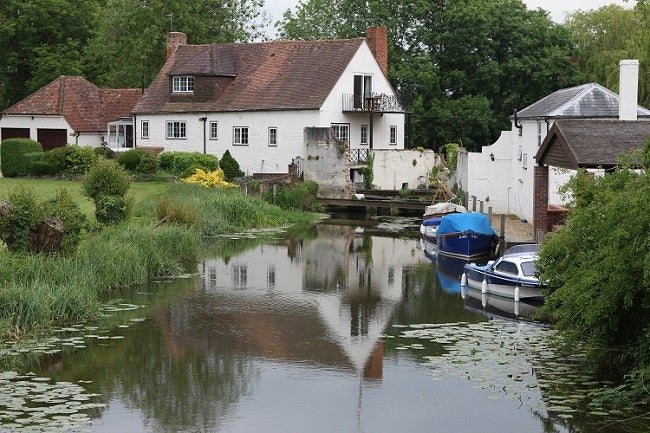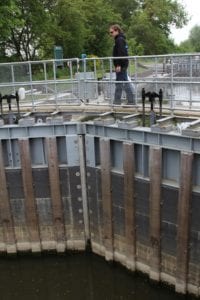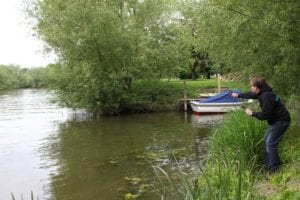We live in a wonderful country where just about every carp in every still water is known…
Rivers, then, represent the last ‘known unknowns’, presenting a tantalising challenge to carp anglers. Catching carp from rivers isn’t always easy, but the reward for doing so is that you may just catch a fish that has never seen a hook before and they fight a little harder, perhaps, simply because they are wild! Do you have what it take to land a wild carp? Well, if you don’t right now, you will once you’ve read our guide to river carp fishing!
Target rivers close to stocked lakes that are prone to flooding.
Location is important when it comes to river carp fishing. Rivers that run close to carp lakes are an excellent place to start. If these carp lakes have flooded in the past, there’s a good chance of carp waiting for you in the nearby river. The larger rivers (the Trent and the Thames, for example) are good places to start, but don’t neglect smaller waterways: the humble River Aire produced a 50lber!
Seek advice from local tackle shops and match anglers.
If you’re not sure where to start, speak with local anglers. Most are friendly folk who love to help other anglers catch fish. If you’re new to an area, or on holiday, try the local tackle shop. This is where all the famous local stories are, and so you’ll likely find the best spot to catch the biggest carp ever seen in the area.
Areas close to house-boats are a good place to start.
Once you’ve selected a river it is a great idea to first roam the banks, preferably during the close season or around spawning time. Okay, you can’t fish, but the carp will be out and about. Areas featuring human activity, like houseboat-moorings, are great. The heat from the boats and the possibility of food scraps, are conducive to keeping carp in the area.
Bait marginal features and clear areas.
Your other option is to create the above situation yourself. Bait-up the kind of areas where you’re accustomed to finding carp on still waters. Also, try and find some areas of slack water; these are places where the carp can rest and conserve energy. Bait and wait to see what happens.
Start your baiting process with pellets and particles.
Now it’s time to really start your baiting. You don’t need to use expensive baits just yet but you may want to introduce these at some point. For now, bulk particles and pellets will help draw in all manner of species and over a few weeks you should know if there are carp present. They may not appear at first (or at all) but this tactic can create a secret gem of a fishing spot!
20lb-plus mainlines and strong snag leaders are advised.
Assuming you’re happy with the area and have found some carp, it is time to fish! River carp are fitter and stronger than lake carp as they live in a harsher environment. When you hook one, be ready! You’ll need to hold on tight and so will your tackle. You’re going to need some tough gear to take on both the carp and the river. Sadly, our rivers are home to man-made snags that you need to be careful of. Don’t be worried about erring on the side of strength over subtlety; these are river carp unused to fishing tackle and less cautious of baited hooks than their still-water counterparts.
5oz leads are required to hold bottom.
You’ll need enough weight on your line to ensure your rig holds bottom in flowing water: 5oz or more is our recommendation. Gripper-leads can help keep your presentation in place too and rigs should be created with the flow of the river in mind. Supple braid, for example, can tie itself in knots and suffer damage from crayfish so stick with mono-line, coated braids or fluorocarbons.
Use large hook bait to keep smaller fish at bay.
Our lakes and rivers contain many species of fish so you’ll know how annoying the smaller species can be when you are trying to catch a big carp. Large hook baits can help keep these at bay. Of course, big baits need big hooks so don’t be afraid to step up to size 2s for the occasion! Also, take a look at the thickness gauges from different manufacturers and buy hooks suitable for the monsters you seek.
Back leads will keep your line away from boat traffic.
Fishing a river, you’re likely to have boat-traffic to deal with so don’t have your rod tip high in the air. Secondly, use back leads as these sink your line below the level of motors and oars – but they can also drag your line into hidden snags so use them with caution. If you’re fishing snaggy water it is best to keep your rod tip low or to fish in the margins away from boats.
Ensure your rods are pinned down with strong butt grips.
Securing your rods and setting your drag correctly is vital – a hooked river-carp doesn’t hang around! Ensure your rod is rock solid with well-planted bank-sticks and strong butt grips. Some river anglers prefer a rod pod anchored to the ground with a bungee cord.
Hit, hold and don’t give too much line.
You should set your reel-drag fairly tight as you don’t want the carp to gain too much advantage before you strike. Also, ensure that you stay beside your rod as you’ll need to act as quickly as possible when a fish takes. Once the fight begins, don’t be afraid to put trust in your tackle. If you’re too easy on your fish it’ll find a snag for sure. You’ve got to be tough to win the day!
River carping is a chance to carve out your own opportunities. It is fun, challenging and always worthwhile! Remember, go prepared and reap the rewards!
Biography
Andrew Patterson is an experienced carp angler who targets lakes and rivers mainly in the Colne Valley area. He runs a carp fishing holiday website, Dream Carp Holidays, which lists a range of lakes in France all available for booking by UK anglers. Website: https://dreamcarpholidays.com/
To comment on this article, go to: https://www.fishingmagic.com/forums/fm-news-feature-comments/366154-guide-river-carp-fishing-andrew-patterson.html#post1495555













